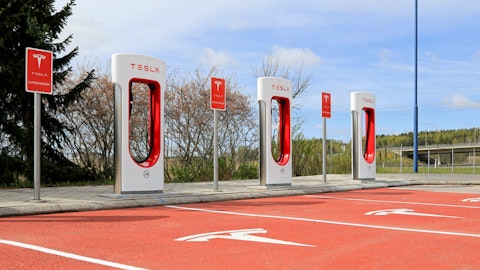Badar Khan: Yes, we see great improvement. And again, Bill, it’s what as we think about the customer experience, uptime is a component of the experience. So having led many asset-based businesses in my career, uptime is a component of the customer experience, which continues to improve, but so does ensuring that the payment process is as fast and quick as possible, making sure that there’s a charger available when a customer goes to a site, which is why we’re targeting more chargers per site, as well as enormous amounts of feedback that customers pay for faster sites. So we’re prioritizing a tweet if you get a lot of chargers. But uptime is certainly improving. Some of the software updates that I talked about earlier in terms of predictive maintenance and sort of diagnostic support are all designed towards improving uptime even more over the course of this year, which leads to reduction in truck rolls, customer calls, and costs in the business.
So we’re pretty good about it.
Bill Peterson: Okay, thanks for that. And then I want to try to talk about gross margin trajectory, I guess taking into account your expectations around utilization, network throughput. How should we think about the gross margin trajectory based off of what you talked about earlier, time of day charging, price increases. But I guess also potential, I guess energy rate either increases or at least time of day charges. And then to remind us, is there any seasonality for that in terms of how that would flow through on the gross margin line?
Olga Shevorenkova: Yes. So gross margin, we reported over 30% for the Q1. However, in my prepared remarks, I mentioned that we had a two and a half million of Nissan break, which recognition, which is typical for Q1, that if inflates, inflates the margin. So like adjusted, adjusted gross margin is in the high 20s. And the expectation for the rest of the year is mid to high 20s. So there is a seasonality to that number, because we are seeing a customer of various utilities and utilities tend to have summer and winter tariffs. And summer and summer is defined in a variety of different ways across different utilities, but it tends to be around the real summer versus around the real winter. And summer tariffs are a little higher than winter. And some cases actually are quite a bit higher than winter. So you should expect to see a little lower margin over the summer period, picking back up by Q4 to the winter time.
Badar Khan: And maybe Bill, if I could just make sure that we, when we talk about gross margin, we are talking, we’re August talking about the entire business, both our charging business, as well as our, the non-charging revenue. We have provided disclosure for you to see for yourself, margins in our charging business specifically. And they were 15, roughly 15% last year. And it started in 2022, up to, up to about 28% in 2023. And this for, this first quarter of 2024, they were in the mid to high 30s, the charging business itself.
Olga Shevorenkova: Yes. And so let me maybe clarify my answer as well. Business, when I quoted the absolute numbers, when I talk about the dynamics, it’s related to charging business. When we talk about the dynamics and extent business, just to add to what Badar said, that you probably see a stable gross margin profile throughout the year versus Q1 and Q4.
Bill Peterson: Okay. Thanks, Olga. And thanks, Badar.
Badar Khan: Yes.
Operator: And this concludes our question and answer session. I will now turn the call back over to CEO Badar Khan for some final closing remarks.
Badar Khan: Great. Well, thank you, everyone, for the call. We, we had a great, another great and record quarter. As you heard, we have very compelling new economics and operating leverage that drives very strongly in the near term, and a growth engine that is generating strong returns for our investors. The change in the competitive landscape that we’ve hoped that we’ve talked about presents even greater opportunities for EVGO to accelerate growth and deliver even stronger returns, taking advantage of the multiple sources of competitive advantage that we now have. And I look forward to providing updates on these competitive advantages in our priorities and progress on subsequent calls. Thanks very much, everyone.
Operator: This concludes today’s conference call. Thank you for your participation. You may now disconnect.
Follow Evgo Inc. (NASDAQ:EVGO)
Follow Evgo Inc. (NASDAQ:EVGO)
Receive real-time insider trading and news alerts



